i9600 Series Writers
Installation
Planning
Guide
For Version 2.0
A-61062
Safety and Installation Information for the Kodak i9600 Series Writer
IMPORTANT: Equipment shall be installed by qualified personnel.
WARNING: Dangerous voltage. Disconnect the main power before installation.
User Precautions
Users and their employer need to observe the common sense precautions applicable to the operation of
any machinery. These include, but are not limited to, the following:
• Do not wear loose clothing, unbuttoned sleeves, etc.
• Do not wear loose jewelry, bracelets, bulky rings, long necklaces, etc.
• Hair length should be kept short, using a hair net if needed, or tying long hair up in a bundle.
• Remove all other loose objects from the area that could be drawn into the machine.
• Take sufficient breaks to maintain mental alertness.
Supervisors should review their practices and make compliance with these precautions a part of the job
description for operation of the Kodak i9600 Series Writers or any mechanical device.
Acoustic Emission
Maschinenlärminformationsverordnung – 3, GSGV
Der arbeitsplatzbezogene Emissionswert beträgt <70 dB(A).
[ Machine Noise Information Ordinance – 3, GSGV
– The operator-position noise emission value is <70 dB(A) ].
Power System Connection
This product is also designed for Norwegian IT power systems with phase-to-phase voltage 230V.
Netzanschluß
Das Gerät ist auch für die Verwendung im norwegischen IT-Stromsystem mit einer Leiterspannung von 230 V
geeignet.
Connexion aux systèmes d'alimentation électrique
Ce produit est également conçu pour les systèmes norvégiens d'alimentation électrique informatique,
dont la tension par phase est de 230 V.
Safety, regulatory conformance and certifications
The Kodak i9600 Series Writer conforms to all applicable national and international product safety and
electronic emission regulatory requirements. This includes, but is not limited to, the following:
• UL 60950, 3rd Edition
• CAN /CSA, C22.2 No. 60950-00
• EN 60950 with +A1, +A2, +A3, +A4, +A11
Electromagnetic compatibility
• USA: CFR47 part 15 sub B, FCC Class A
• Canada: ICES-003 Issue 3, Class A
• Australia / New Zealand: AS/NZS 3548, Class A
• Japan: VCCI, Class A
• Taiwan: CNS 1343, Class A
• European Union
− EN 55022:95, ITE Emissions Class B
− EN 61000-3-2 Powerline Harmonics
− EN 61000-3-3 Flicker
− EN 55024:95 ITE Immunity
Electromagnetic Compatibility Statements
United States
NOTE: This equipment has been tested and found to comply with the limits for a Class A digital device,
pursuant to part 15 of the FCC rules. These limits are designed to provide reasonable
protection against harmful interference when the equipment is operated in a commercial
environment. This equipment generates, uses and can radiate radio frequency energy and, if
not installed and used in accordance with the instruction manual, may cause harmful
interference to radio communications. Operation of this equipment in a residential area is likely
to cause harmful interference in which case the user will be required to correct the interference
at their own expense.
Taiwan
Japan
Table of Contents
Introduction ................................................................................................1
Site Specifications......................................................................................1
Layout considerations .........................................................................1
Dimensions and weight .......................................................................2
Space requirements ............................................................................2
Operating conditions ...........................................................................2
Static electricity....................................................................................2
Electrical requirements ..............................................................................3
Power outlets.......................................................................................3
Power cords.........................................................................................4
Grounding requirements......................................................................4
Acoustic noise .....................................................................................4
System requirements ................................................................................5
Hardware requirements.......................................................................5
Software requirements ........................................................................5
Network connectivity and cables ...............................................................6
Network address .................................................................................8
Defining a Writer..................................................................................8
Writer/Host PC communication ...........................................................9
Boot up sequence ...............................................................................9
Network design considerations..................................................................9
Network design recommendations ............................................................10
Installation and training responsibilities .....................................................11
Reseller responsibilities .............................................................................11
Customer/Buyer responsibilities ................................................................11
Kodak responsibilities ................................................................................12
Enhancement services offered ..................................................................12
Kodak Imaging network services ...............................................................12
Delivery / Installation..................................................................................13
Liaison ................................................................................................13
Delivery................................................................................................13
Inspecting shipment ............................................................................13
Claims process....................................................................................14
Equipment delivery removal ................................................................15
Scheduling hardware installations.......................................................15
Hardware installation...........................................................................15
Service and Support ..................................................................................16
Training ................................................................................................18
Publications and ordering information .......................................................18
New Equipment Warranty..........................................................................19
A-61062 November 2006 i
Kodak i9600 Series Writers
Introduction The Kodak i9600 Series Writers provide the
capability of writing digital images to archive
media. Image files are accepted from a host
system, decompressed, composed along with
image marks and optional frame annotation,
and converted to analog format. The resulting
images are written to Kodak Reference
Archive Media.
Two models of the i9600 Writer are available:
•Kodak i9610 Writer: writes up to 4800 scan
lines per second.
•Kodak i9620 Writer: writes up to 9600 scan
lines per second.
This manual provides site specification information for the Kodak i9600
Series Writer (both models). Any information that is pertinent to a
specific model will be noted.
Site specifications Check that the designated site for the Kodak i9600 Series Writer meets the
following conditions and space requirements.
Layout considerations The following should be considered when selecting a site for the i9600
Series Writers:
• Position the Writer to allow for:
- Clearance space between other equipment and doorways.
- A maximum distance of 5 feet (1.5 meters) from the Writer to the
power outlets.
• Position the Writer away from:
- Potential flooding and dampness areas, especially in basement
areas.
- Open flame, excessively dusty areas or direct sunlight.
- Any combustible or corrosive atmosphere caused by volatile liquids
or solvents.
- Heat sources, such as windows, baseboard heating units, heat
ducts, space heaters, or any heat-generating equipment.
- Transmitted interference, such as that generated by electronic air
cleaners, communication transmitters, radar (FAA and military), or
power lines.
• Locate air conditioning outlets so the Writer will receive optimum air
circulation.
• Any floor vibration caused by air conditioning units, etc.
• Establish an entry point for the communication cable to avoid laying it
across the floor or passageway.
A-61062 November 2006 1
Dimensions and weight The table below details the physical dimensions and weights for the
Writer.
Dimensions Writer With Shipping Carton
Width 615 mm (24. 2 in.) 775 mm (30.5 in)
Length 810 mm (31.9 in.) 973 mm (38.3 in.)
Height 1196 mm (47.1 in.) 1575 mm (62 in.)
Weight (approx.) 159 kg (350 lbs) 182 kg (400 lbs)
Space requirements Recommended space requirements for servicing the Writer:
4 in.
(102 mm)
(Back)
i9600 Series
Writer
31.9 in. 24 in.
(810 mm) (610 mm)
(Front of Writer)
24.2 in.
(615 mm)
Top View
The Writer is on casters so it can be moved to reach the main power
switch located in the back of the unit. All operator procedures are
accessible from the front of the unit.
NOTES:
• When removing the Writer from the pallet for unpacking, you must
have a 3.0 m (10-foot) clearance on all sides.
• 5 inches (127 mm) of clearance is required to open the Writer door.
Operating conditions Temperature range: 15 to 30°C (59 to 86°F)
Relative humidity: 15 to 76%
Altitude: Barometric pressure - 0.6 to 1 atm
Static electricity Buildup of static electricity near the Writer does not affect operation.
2 A-61062 November 2006
Electrical requirements Acceptable operational voltage:
Voltage Hz/Cycles Amps
100–127 V ac 50/60 Hz, 1 phase 3 amps at 120 V ac
198–254 V ac 50/60 Hz, 1 phase 1.5 amps at 240 V ac
NOTE: Power usage is equivalent to 1231 Btu/hr.
• Neutral to ground impedance is less than (<) 2 ohms.
• Neutral to ground voltage is less than (<) 1 volt ac maximum.
• Maximum impulse voltage spikes: 50% of nominal line voltage
maximum.
• Maximum voltage surge: 5% of nominal line voltage maximum.
• Maximum power usage for all configurations is 360 kVA.
The acceptable operational frequency range is from +3 to -3 Hz from
nominal frequency. The equipment may malfunction if frequency is
outside of this specified range.
Consult with your electrical contractor or utility company to ensure on-
site wiring complies with the Writer specifications and wall outlets use
isolated grounds and comply with codes.
Power outlets A separate, dedicated power line is highly recommended for each
Writer.
One individual dedicated branch AC circuit employing two standard
3-prong, grounded duplex outlets is required.
Hot
Neutral
Ground
The outlets should meet the following standards:
• Amperage: 15 amp
• Wire size: 12-gauge — minimum
• Phase: 1 (single)
• Voltage drop across the circuit breaker: less than 0.1 volts
NOTE: Receptacles should be placed within 1.5 meters (5 feet) of the
equipment.
Because multiple outlets are usually wired together on a single circuit,
you must know which outlets are controlled by each circuit breaker and
the steady state current draw of the equipment to be plugged into each
circuit.
A-61062 November 2006 3
Power cords A 3-prong, grounded power cord is provided with the Writer. The power
cord receptacle is a NEMA 5-15P. The maximum power cord length is 2
meters (6.5 feet).
Special plugs and cords may be required outside of the United States
and Canada; these will be provided by the Kodak distributor (the power
cord provided for international locations must be at least 14-gauge
wire).
CAUTION: Make certain nothing obstructs or is placed on power
cords. Do not use extension cords; they can cause
voltage loss which may result in unreliable equipment
performance or equipment damage.
Grounding requirements Use the standard grounding power cable which is supplied with the
Writer or an equivalent locally procured grounding power cable.
The Writer can be grounded to the following objects:
• Grounding terminal of wall outlet
• Copper bar buried more than 650 mm (25.6 in.) under the ground
• Water service pipe authorized by the local Water utility as a ground
(never use a gas pipe)
Acoustic noise The chart below provides acoustic noise levels, which are measured in
accordance with DIN 45 635, ANSI S12.10-1985, and ISO 7779 in a
hemi-anechoic chamber.
Acoustic Noise Noise Level dB (A)
Standby 33 dB (A)
Operating 50 dB (A)
4 A-61062 November 2006
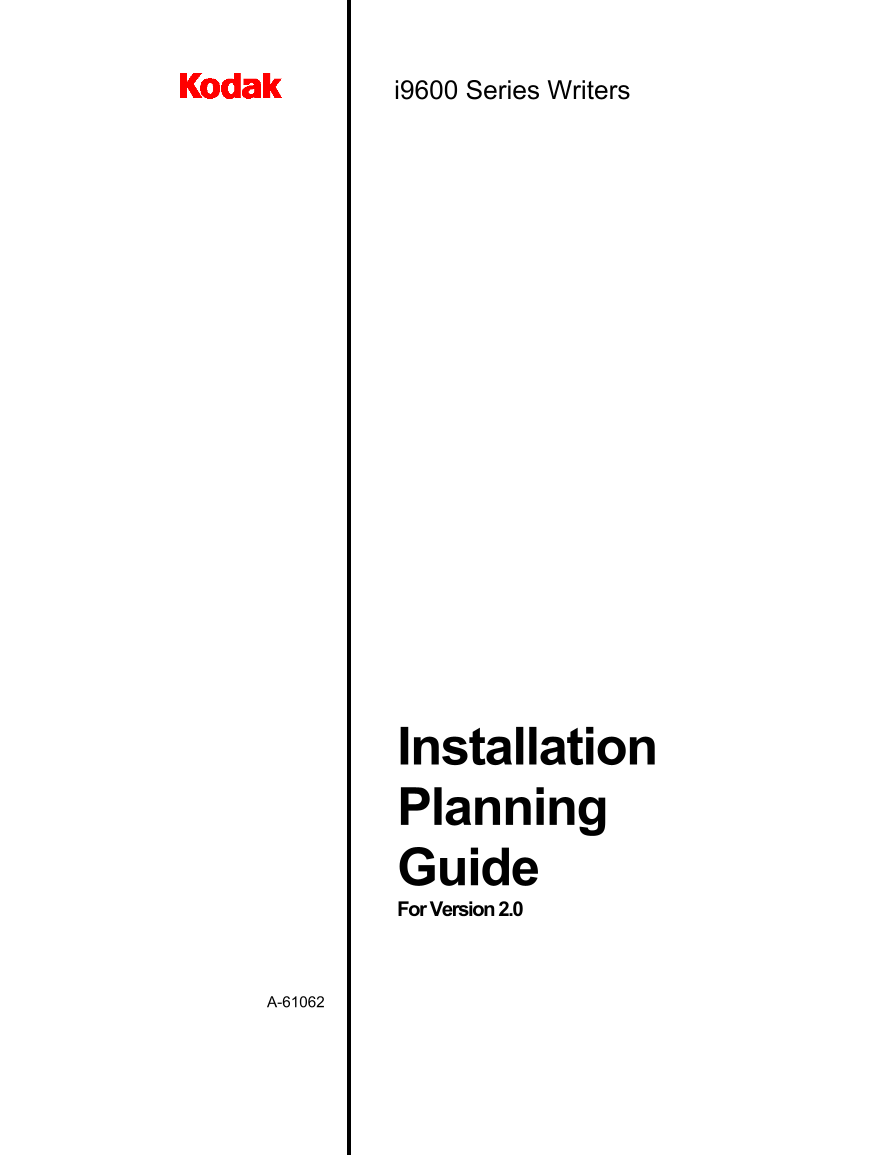
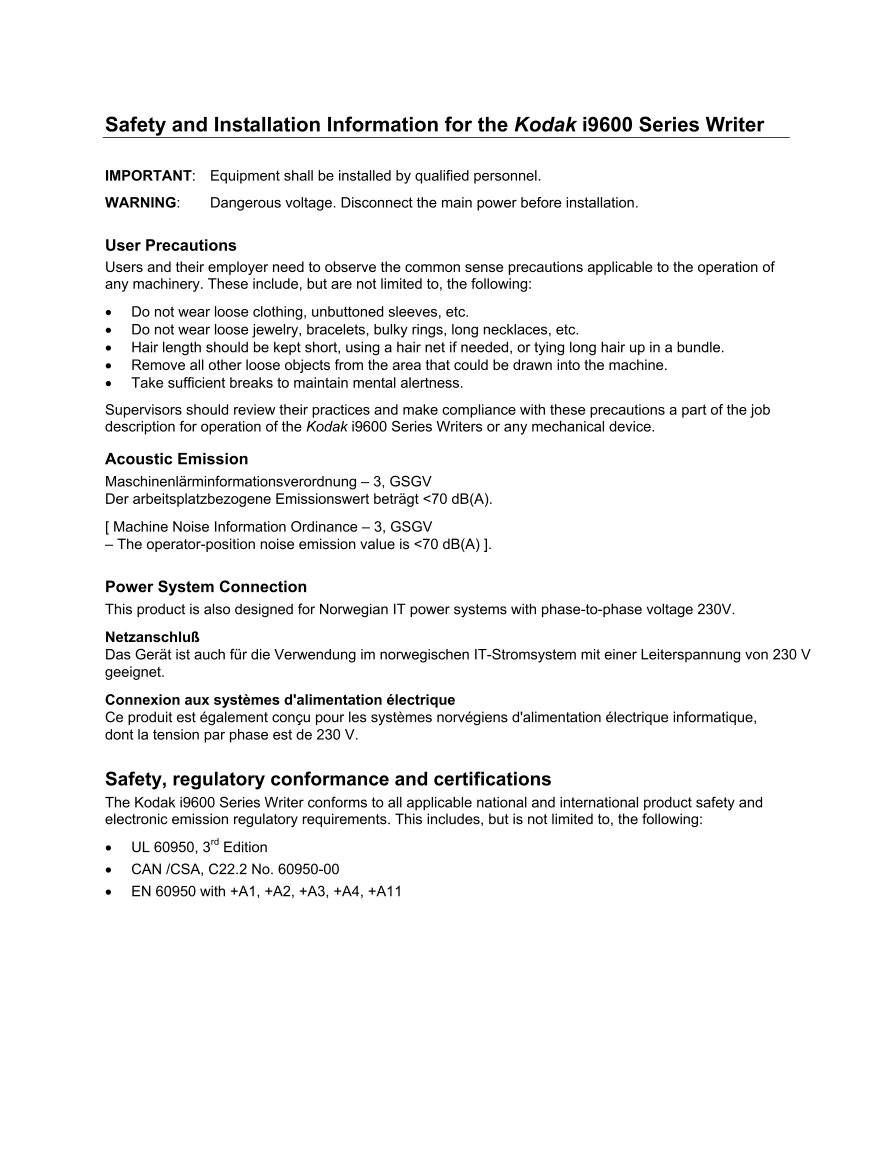
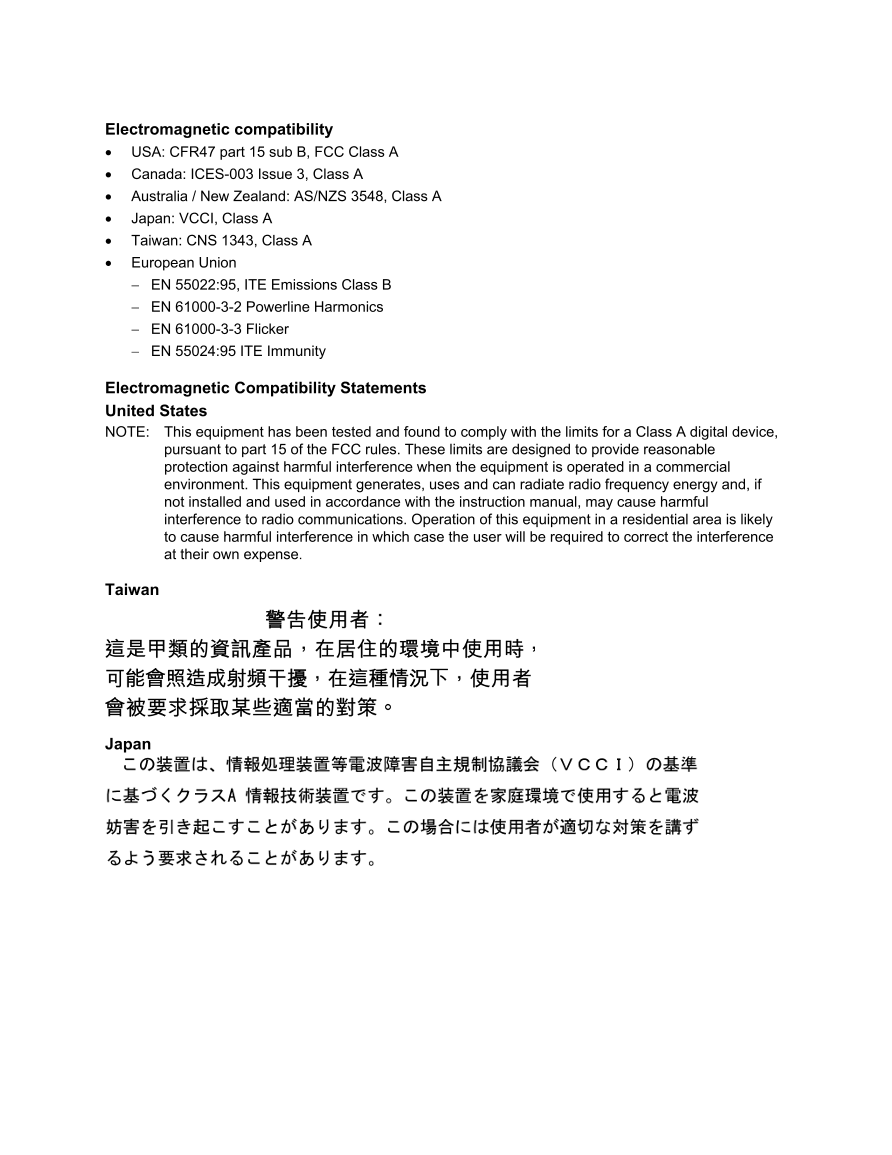
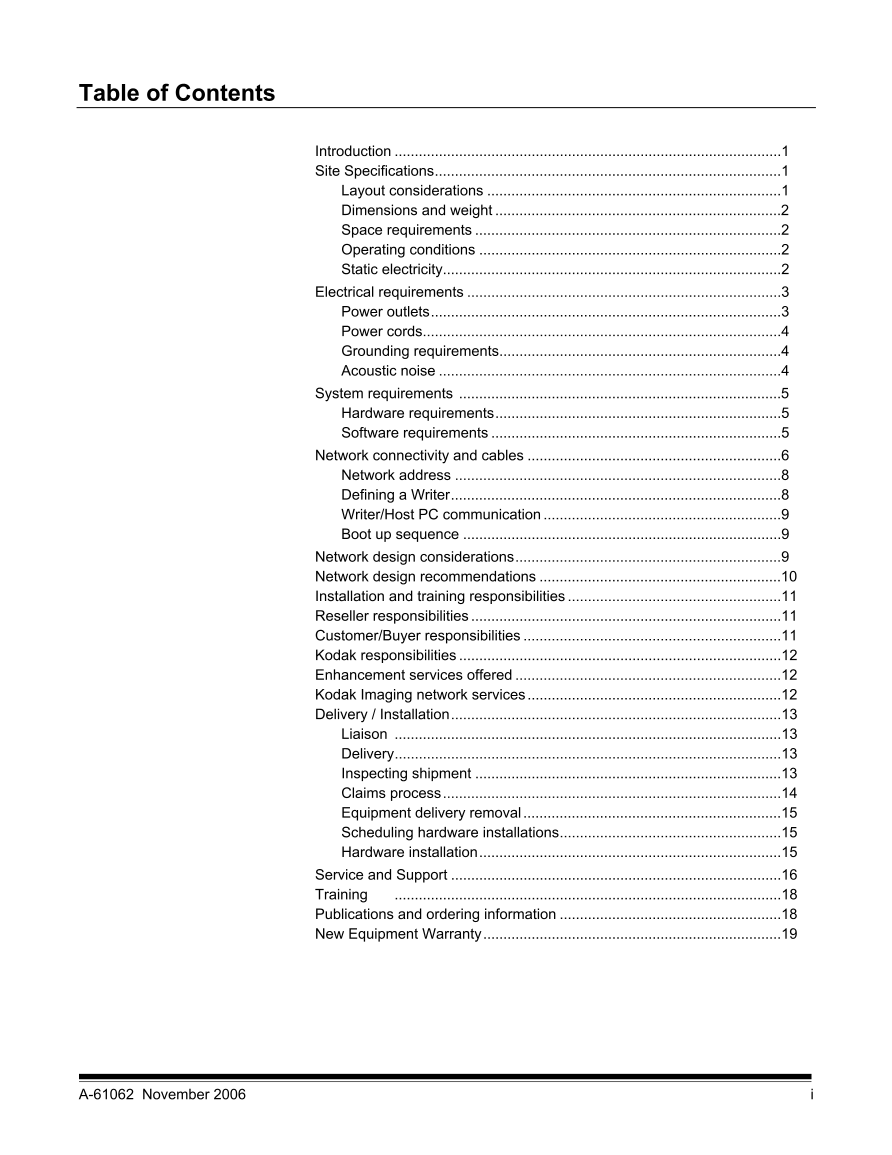


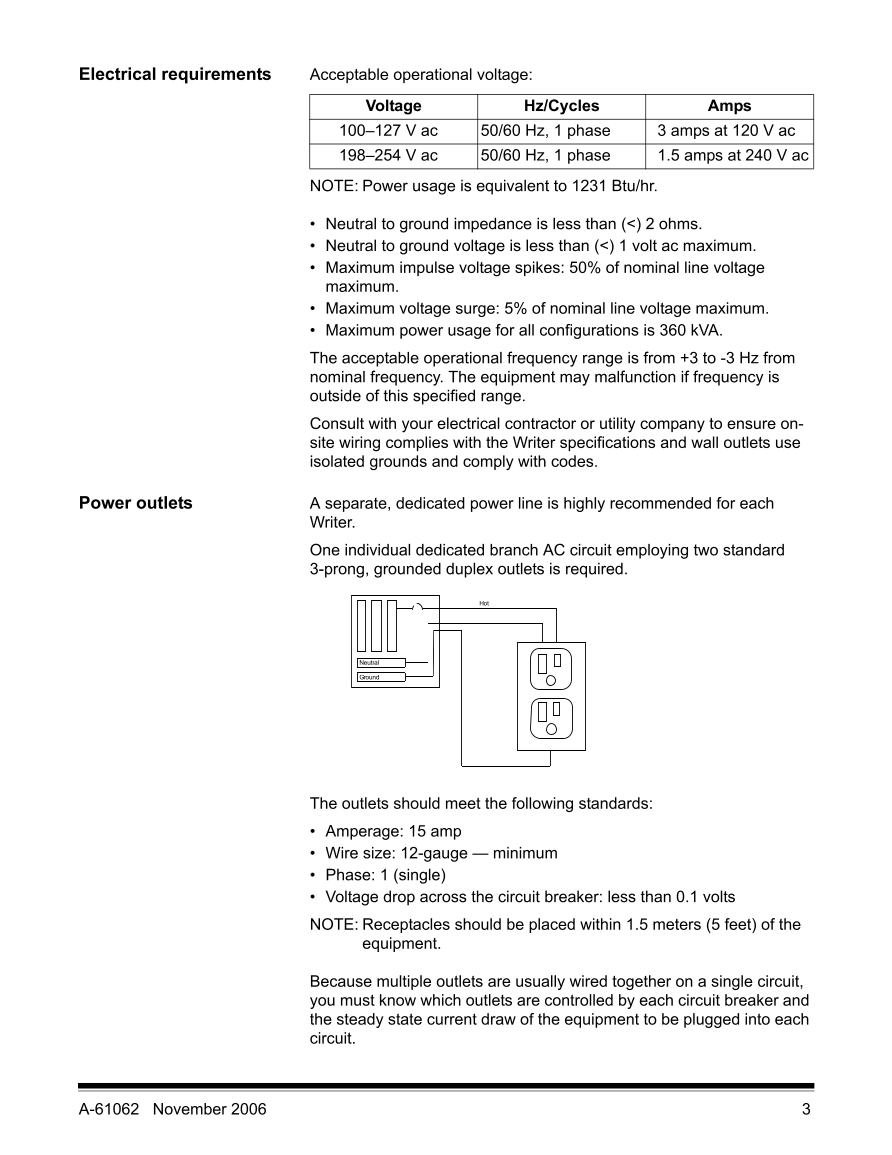
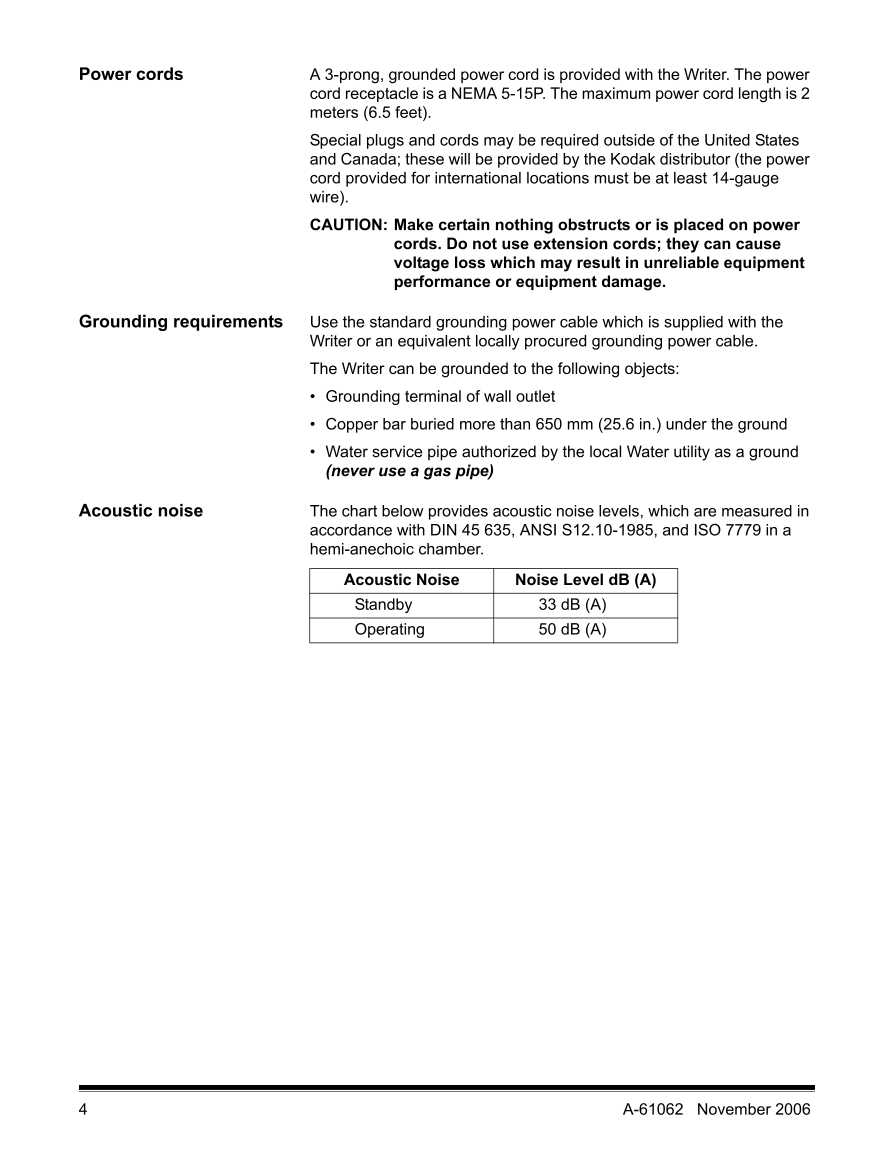








 V2版本原理图(Capacitive-Fingerprint-Reader-Schematic_V2).pdf
V2版本原理图(Capacitive-Fingerprint-Reader-Schematic_V2).pdf 摄像头工作原理.doc
摄像头工作原理.doc VL53L0X简要说明(En.FLVL53L00216).pdf
VL53L0X简要说明(En.FLVL53L00216).pdf 原理图(DVK720-Schematic).pdf
原理图(DVK720-Schematic).pdf 原理图(Pico-Clock-Green-Schdoc).pdf
原理图(Pico-Clock-Green-Schdoc).pdf 原理图(RS485-CAN-HAT-B-schematic).pdf
原理图(RS485-CAN-HAT-B-schematic).pdf File:SIM7500_SIM7600_SIM7800 Series_SSL_Application Note_V2.00.pdf
File:SIM7500_SIM7600_SIM7800 Series_SSL_Application Note_V2.00.pdf ADS1263(Ads1262).pdf
ADS1263(Ads1262).pdf 原理图(Open429Z-D-Schematic).pdf
原理图(Open429Z-D-Schematic).pdf 用户手册(Capacitive_Fingerprint_Reader_User_Manual_CN).pdf
用户手册(Capacitive_Fingerprint_Reader_User_Manual_CN).pdf CY7C68013A(英文版)(CY7C68013A).pdf
CY7C68013A(英文版)(CY7C68013A).pdf TechnicalReference_Dem.pdf
TechnicalReference_Dem.pdf